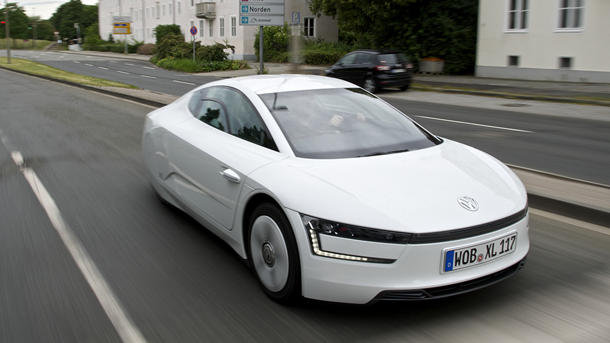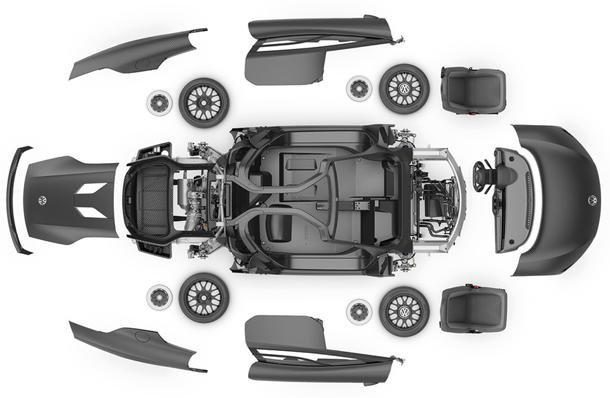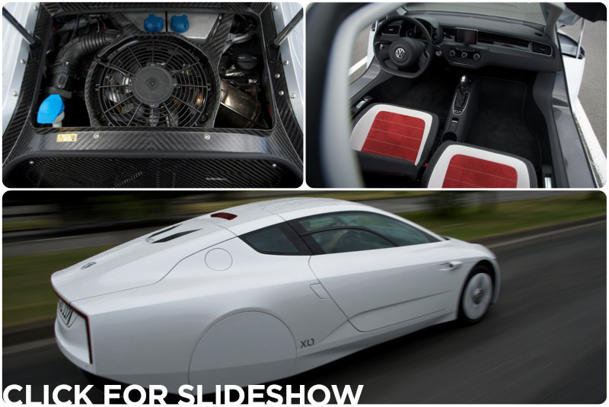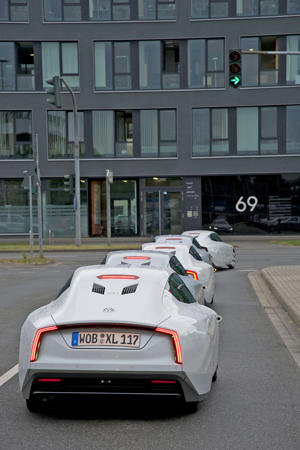Volkswagen announces the XL1, a car that averages at 262 miles per gallon

Since the dawn of the combustion age, true car nuts have disdained gas mileage as the obsession of the weak-minded and unskilled; there’s no bigger punchline in the business than the Toyota Prius. The success of the Tesla Model S has begun to change the culture, but when it comes to supercars, faster and more powerful roughly equals better, while efficiency gets dismissed with prejudice.
Well, the Volkswagen XL1 may be the transformative alternative-energy vehicle, the one that finally arouses the car fiend from his gas-hungry stupor. The XL1 is a different conception of a car, a German engineer’s dream of hyper-miling. It contains no driving joy or spirit, just lots of cool, stripped-down design details, an anschulss of movement and MPG that gets an average of 262 mpg. This is ze car we’ve been waiting for.
The XL-1 doesn’t have a rear-view mirror, which makes sense, since it also doesn’t have a rear window. Other things not present in this car: Wheels thicker than a street bike’s, a backseat, or any semblance of wind resistance. It has a drag coefficient of 0.189, which, if you’re not keeping score, is almost impossibly low, less that your average bumblebee’s. Because of this, its engineers claim the XL1 can glide at reasonable speed on the autobahn using only eight horsepower.
Now that I’ve actually driven the XL1 on the highway, I don't doubt it. The thing is so compact and thin I’m surprised they didn’t just slip it underneath my hotel-room door along with my departure notice. The XL1 looks like a Blade Runner hovercar and drives like something from Disneyland’s Autopia, but without the attendant stink. Though it has an “S” mode, which ostensibly means “sport,” you’d be hard-pressed to detect such a function in the powertrain. “This,” one of its engineers told me in Germany last week, “was not the focus of our development.”

The XL1 represents the car as blue-ribbon science fair project. But unlike other megacars, which are built to maximize speed and power, this one, more than ten years and upward of a billion dollars in the designing, contains not one centimeter of wasted space or poundage. The engineers eliminated power steering because it would have added 10 kilograms. For maximum lightness, the core of its body and chassis is comprised of a one-piece molded carbon-fiber monocoque. The magnesium wheels get wrapped in custom-light Michelin rubber. The windows lower with hand cranks. There’s no radio — the sound system wraps through the Garmin GPS — and no place to plug in your smartphone, because Bluetooth is lighter.
All of this results in a car that weighs 1,753 lbs. Under its rear hatch lies a two-cylinder diesel that generates 47 hp, which would have been fairly weak in 1960, much less in the era where the average Hyundai generates up to 200 hp. The XL1 has a 27-hp electric battery, which can propel it about 31 miles on its own, up to 62 mph. It can fully recharge, Volkswagen says, in an hour and a half. The maximum speed overall, using the full hybrid drivetrain, is 94 mph. There’s a 2.6-gallon fuel tank, which lets the XL1 achieve a total range of 310 miles — since it can't be run at maximum efficiency all of the time.
The car is a design marvel, with a front that looks as smooth and modern as a Mercedes S-class, and a rear that doesn’t so much taper off as disappear into the void. Even the rear wheels are hidden by metal coverings, making it look like the car is balancing entirely on its forelegs. When viewed from the rear, XL1 is angular and beautiful, a shiny metal bolt, or maybe a super suppository.

In true supercar fashion, the doors open in dramatic gull-wing style, making the XL1 look like a personalized drone. When both are up, the car’s cockpit manifests dramatically, like a robot Easter egg. The trunk opens with less style, but contains a nifty-looking carbon-fiber XL1 logo, and enough cargo space to hold a small weekend bag.
Inside, the seats are high-end canvas, looking appreciably cool and sporty. Everything else is streamlined and light. The steering wheel has a flat bottom, like a race car’s, or at least a racing simulator’s. In general, “simulated” is the best way to describe the way the XL-1 drives.
To repeat, the car has no rear-view mirror. It also doesn’t have side mirrors, which the engineers replaced to reduce drag. In their place are side-mounted cameras, meaning that when you drive the car, you have to watch two camera feeds at once at once to not only monitor your blind spots, but every spot. “We are convinced that the side cameras are enough,” an engineer told me. “It’s difficult when you first start but you get used to it.”

I must respectfully dissent. The XL1’s other quirks, like the whooshing sound of the carbon-disc brakes, the strange growly noises the engine makes in diesel mode, and the lack of power steering, not to mention the raw, low overall feel of the ride — those I could get used to. It’s what you’d expect out of a hyper-miled car. You have to sacrifice a little comfort and performance. But for a car you need to drive yourself, one that contains no lane-departure warnings or other modern safety features, not having a rear-view mirror is just dangerous.
This wasn’t a carnival ride or a test-track. I took the XL1 into city traffic, in a foreign country, in the middle of the afternoon, and it was terrifying. Trying to wrench the steering wheel was hard enough, though I figured it out after a while. Also, I drive a lot of hybrids, so I didn’t find the lack of pickup in the XL1 disturbing. But I did find it hard to enjoy the fact that I was getting the best gas mileage of all time because I could not really see behind me. You try that sometime.
When I hit the highway, things got better. The XL1 was actually better to drive at higher speeds. It got up to 140 kmh in due time, and held its speed without trouble. Sure enough, I could feel the glide. It was almost counter-intuitive. These kinds of cars are supposed to be better in the city, but this one almost felt like a cross-country runner, tireless, with hidden reserves. Also, there wasn’t as much traffic, so it removed a certain level of panic from the experience.
Later, at a lecture about the car, one of the engineers said, “There are technology enthusiasts who say the XL1 is perfect, but others who say it’s not good enough yet.” I’m not sure where I fall on that scale, honestly. I’m also not sure that the XL1 really exists outside of an R&D concept.
Volkswagen has made 50 of them so far. They’re using a few for test-driving, and the rest are currently in the hands of fortunate Eurozone residents who won an essay contest about green energy and urban design. The plan, VW says, is to manufacture about 250 total, but they won’t say whether they plan to sell or less them, won’t say exactly when, and won’t give an idea about how much they’re going to cost. It’s only going to be Europe, though; residents of North America will either have to spot a rarity in the wild or see one in a museum in the future.
There’s also no indication of what extraordinary XL1 related tech, other than the two-cylinder hybrid drive-train, already in use in VW’s Up! budget compact, will appear in other Volkswagen group cars. I suspect that the XL1’s brave new ground in airflow intake will affect how we drive in the future, and I wouldn’t be surprised to see carbon-fiber creep as the public begins to relentlessly clamor for more monocoque. In the future, hopefully, more cars will be small and weird and cool and slow and awesome and really fuel-efficient.
Let’s just hope they have rear-view mirrors.
Source: http://autos.yahoo.com/blogs/motoramic/volkswagen-xl1-wheeling-262-mpg-orb-motoramic-drives-172831276.html

Since the dawn of the combustion age, true car nuts have disdained gas mileage as the obsession of the weak-minded and unskilled; there’s no bigger punchline in the business than the Toyota Prius. The success of the Tesla Model S has begun to change the culture, but when it comes to supercars, faster and more powerful roughly equals better, while efficiency gets dismissed with prejudice.
Well, the Volkswagen XL1 may be the transformative alternative-energy vehicle, the one that finally arouses the car fiend from his gas-hungry stupor. The XL1 is a different conception of a car, a German engineer’s dream of hyper-miling. It contains no driving joy or spirit, just lots of cool, stripped-down design details, an anschulss of movement and MPG that gets an average of 262 mpg. This is ze car we’ve been waiting for.
The XL-1 doesn’t have a rear-view mirror, which makes sense, since it also doesn’t have a rear window. Other things not present in this car: Wheels thicker than a street bike’s, a backseat, or any semblance of wind resistance. It has a drag coefficient of 0.189, which, if you’re not keeping score, is almost impossibly low, less that your average bumblebee’s. Because of this, its engineers claim the XL1 can glide at reasonable speed on the autobahn using only eight horsepower.
Now that I’ve actually driven the XL1 on the highway, I don't doubt it. The thing is so compact and thin I’m surprised they didn’t just slip it underneath my hotel-room door along with my departure notice. The XL1 looks like a Blade Runner hovercar and drives like something from Disneyland’s Autopia, but without the attendant stink. Though it has an “S” mode, which ostensibly means “sport,” you’d be hard-pressed to detect such a function in the powertrain. “This,” one of its engineers told me in Germany last week, “was not the focus of our development.”

The XL1 represents the car as blue-ribbon science fair project. But unlike other megacars, which are built to maximize speed and power, this one, more than ten years and upward of a billion dollars in the designing, contains not one centimeter of wasted space or poundage. The engineers eliminated power steering because it would have added 10 kilograms. For maximum lightness, the core of its body and chassis is comprised of a one-piece molded carbon-fiber monocoque. The magnesium wheels get wrapped in custom-light Michelin rubber. The windows lower with hand cranks. There’s no radio — the sound system wraps through the Garmin GPS — and no place to plug in your smartphone, because Bluetooth is lighter.
All of this results in a car that weighs 1,753 lbs. Under its rear hatch lies a two-cylinder diesel that generates 47 hp, which would have been fairly weak in 1960, much less in the era where the average Hyundai generates up to 200 hp. The XL1 has a 27-hp electric battery, which can propel it about 31 miles on its own, up to 62 mph. It can fully recharge, Volkswagen says, in an hour and a half. The maximum speed overall, using the full hybrid drivetrain, is 94 mph. There’s a 2.6-gallon fuel tank, which lets the XL1 achieve a total range of 310 miles — since it can't be run at maximum efficiency all of the time.
The car is a design marvel, with a front that looks as smooth and modern as a Mercedes S-class, and a rear that doesn’t so much taper off as disappear into the void. Even the rear wheels are hidden by metal coverings, making it look like the car is balancing entirely on its forelegs. When viewed from the rear, XL1 is angular and beautiful, a shiny metal bolt, or maybe a super suppository.

In true supercar fashion, the doors open in dramatic gull-wing style, making the XL1 look like a personalized drone. When both are up, the car’s cockpit manifests dramatically, like a robot Easter egg. The trunk opens with less style, but contains a nifty-looking carbon-fiber XL1 logo, and enough cargo space to hold a small weekend bag.
Inside, the seats are high-end canvas, looking appreciably cool and sporty. Everything else is streamlined and light. The steering wheel has a flat bottom, like a race car’s, or at least a racing simulator’s. In general, “simulated” is the best way to describe the way the XL-1 drives.
To repeat, the car has no rear-view mirror. It also doesn’t have side mirrors, which the engineers replaced to reduce drag. In their place are side-mounted cameras, meaning that when you drive the car, you have to watch two camera feeds at once at once to not only monitor your blind spots, but every spot. “We are convinced that the side cameras are enough,” an engineer told me. “It’s difficult when you first start but you get used to it.”

I must respectfully dissent. The XL1’s other quirks, like the whooshing sound of the carbon-disc brakes, the strange growly noises the engine makes in diesel mode, and the lack of power steering, not to mention the raw, low overall feel of the ride — those I could get used to. It’s what you’d expect out of a hyper-miled car. You have to sacrifice a little comfort and performance. But for a car you need to drive yourself, one that contains no lane-departure warnings or other modern safety features, not having a rear-view mirror is just dangerous.
This wasn’t a carnival ride or a test-track. I took the XL1 into city traffic, in a foreign country, in the middle of the afternoon, and it was terrifying. Trying to wrench the steering wheel was hard enough, though I figured it out after a while. Also, I drive a lot of hybrids, so I didn’t find the lack of pickup in the XL1 disturbing. But I did find it hard to enjoy the fact that I was getting the best gas mileage of all time because I could not really see behind me. You try that sometime.
When I hit the highway, things got better. The XL1 was actually better to drive at higher speeds. It got up to 140 kmh in due time, and held its speed without trouble. Sure enough, I could feel the glide. It was almost counter-intuitive. These kinds of cars are supposed to be better in the city, but this one almost felt like a cross-country runner, tireless, with hidden reserves. Also, there wasn’t as much traffic, so it removed a certain level of panic from the experience.
Later, at a lecture about the car, one of the engineers said, “There are technology enthusiasts who say the XL1 is perfect, but others who say it’s not good enough yet.” I’m not sure where I fall on that scale, honestly. I’m also not sure that the XL1 really exists outside of an R&D concept.
Volkswagen has made 50 of them so far. They’re using a few for test-driving, and the rest are currently in the hands of fortunate Eurozone residents who won an essay contest about green energy and urban design. The plan, VW says, is to manufacture about 250 total, but they won’t say whether they plan to sell or less them, won’t say exactly when, and won’t give an idea about how much they’re going to cost. It’s only going to be Europe, though; residents of North America will either have to spot a rarity in the wild or see one in a museum in the future.
There’s also no indication of what extraordinary XL1 related tech, other than the two-cylinder hybrid drive-train, already in use in VW’s Up! budget compact, will appear in other Volkswagen group cars. I suspect that the XL1’s brave new ground in airflow intake will affect how we drive in the future, and I wouldn’t be surprised to see carbon-fiber creep as the public begins to relentlessly clamor for more monocoque. In the future, hopefully, more cars will be small and weird and cool and slow and awesome and really fuel-efficient.
Let’s just hope they have rear-view mirrors.
Source: http://autos.yahoo.com/blogs/motoramic/volkswagen-xl1-wheeling-262-mpg-orb-motoramic-drives-172831276.html

